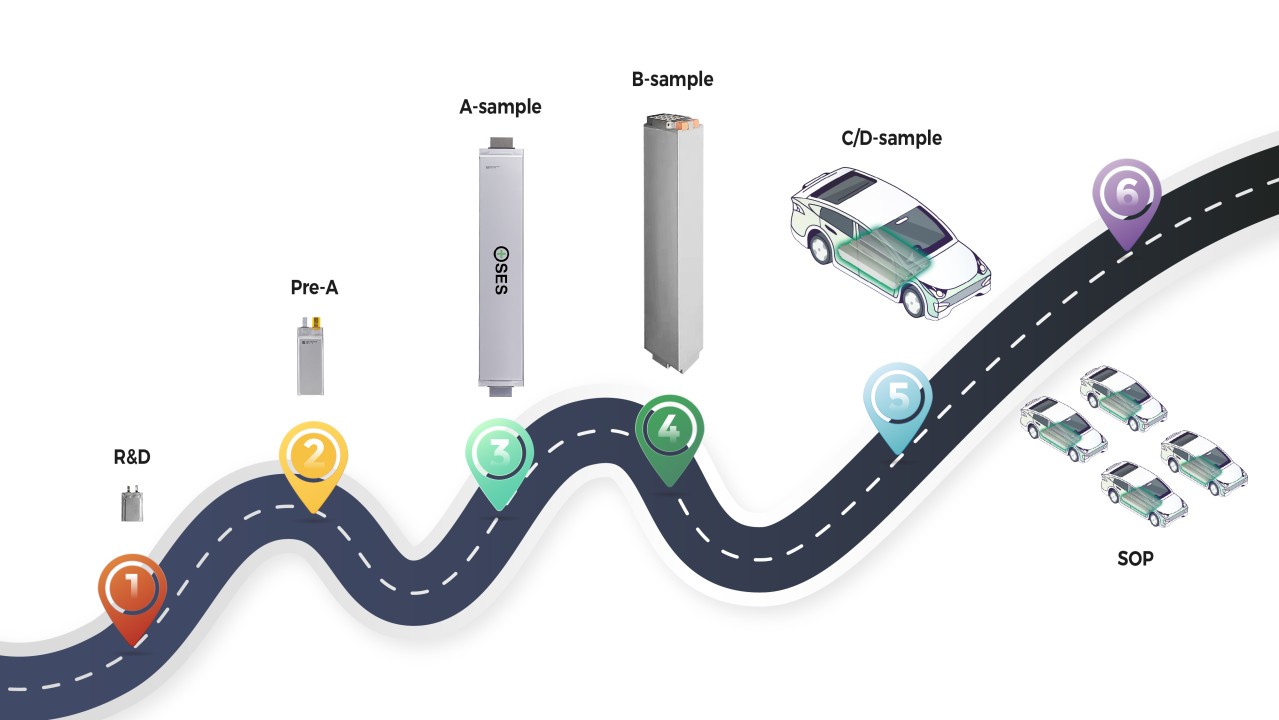
March 30, 2022 The A-Sample: The long and winding road to commercialization
Often we hear in the media about some great battery breakthroughs, but then they quickly vanish. The road to commercialization is long and winding. It often takes more than 10 years and hundreds of millions and even billions of dollars, and when one eventually gets to Start-Of-Production, one realizes that the real journey only just begins. Despite such commitment, the reward and satisfaction are immense, and this journey continues to attract bright young minds, because our world needs it.
In this article, we attempt to shed light on the process that a new battery breakthrough needs to go through from R&D to reach Start-Of-Production. We break it into six steps:
1. R&D
2. Pre-A Sample
3. A-Sample
4. B-Sample
5. C/D-Sample
6. Start-Of-Production
The entire process can take more than 10 years. This is based on our interaction with several automakers, and most automakers around the world follow a similar process.
Step 1. R&D (5+ years)
Making sure the science works
This is the very early proof-of-concept stage, which takes place in universities and national labs, typically in coin cells (~0.005 Ah) or single layer (~0.1 Ah) or a few layer (0.1-0.5 Ah) pouch cells. These cells do not have meaningful actual measured cell energy density and are tested under benign academic conditions. The main objective is to demonstrate that the new concept (could be a new material, new structure or new process) can have the basic electrochemical functions and understand the fundamental failure mechanism to help guide future development and optimization.
This stage helps filter the quality of the new concepts. Most new concepts do not have the basic electrochemical functions and are eliminated. Some new concepts have the basic electrochemical functions and show significant improvement in certain key aspects but much worse performance in all other aspects compared to industry standard, these are pursued but with limited resources. Very few new concepts not only show significant improvement in certain key aspects but equal or better performance in all other aspects compared to industry standard, these are pursued with top priority.
Step 2. Pre-A Sample (1-3 years)
Making sure the technology works in small cells
This is demonstration stage, which takes place in startups, industry R&D and engineering teams, typically in small (1-10 Ah) pouch cells (sometimes small cylindrical cells <10 Ah). These cells have meaningful actual measured cell energy density, at least comparable to industry standard, and typically have 25-35 layers of each electrode (total 50-70 layers) and are tested under rigorous industry conditions.
The main objective of this stage is to test and validate the new battery breakthroughs on a more commercial platform, including cell energy density, performance (fast charge, cycling, different temperature and current density, storage, impedance, etc.) and safety. It also helps identify potential challenges in manufacturing and cost. In this stage the battery companies and automakers start to work closely together, but the scale of collaboration is small typically <$10 m. Most new battery breakthroughs vanish in this stage and they show marginal improvement in one aspect but significantly worse performance in all other aspects compared to industry standard.
Step 3. A-Sample, Concept Validation CV (1-2 years)
Making sure the technology works in full commercial cells
Very few new battery breakthroughs make it to this stage. This is validation stage, takes place in more mature startups and industry engineering teams, typically in large pouch cells (50-100 Ah) and have the same format as the final commercial cells that will eventually go into vehicles. These cells already went through demonstration stage in Pre-A Sample and now need to go through even more rigorous tests in larger final commercial cells. The collaboration between battery companies and automakers enters a new level, teams from not only R&D, but engineering, product and manufacturing are involved, and the scale increases to $50m to $100m (pure collaboration funding, not including any financial investment). The main objective of this stage is to develop a set of engineering design, manufacturing process and material combinations to meet the final specifications for the final commercial cells. This stage is extremely challenging as the design and test conditions are much more real and rigorous, and there are real world constraints such as cost and design form factor that must be considered. By the time a new battery breakthrough completes A-sample, the cell technology is considered fully de-risked.Step 4. B-Sample Design Validation DV (1-2 years)
Making sure the technology works in modules and packs
This is an extension of A-Sample. The cell design and material combinations are frozen and cell performance meet specifications. The cells are integrated into modules and packs for further testing. Manufacturing process development becomes a top priority, to increase production speed by 3-5x from A-sample to B-sample and by another 3-5x from B-sample to C-sample.
The main objective of this stage is to further test and optimize A-Sample at cell, module and pack level, fully meet specifications, and develop the manufacturing process and supply chain needed to scale by 10-30x from A-Sample to C-Sample.
By the time a new battery breakthrough completes B-Sample, the module and pack technology are considered fully de-risked, and its supply chain and manufacturing process are considered to have no show-stopper risks.
Step 5. C/D-Sample Process and Production Validation PV (1-2 years)
Making sure technology, manufacturing, and supply chain all work in large production scale and when integrated in vehicles under all environments
This is vehicle testing stage. The B-Samples are assembled into modules and packs and integrated into demo vehicles (a few hundreds and to a few thousands) for actual vehicle testing. The cells are pulled from actual production lines operating at target speed while meeting quality and process certifications. The cells have the same format as A-Sample (50-100 Ah), but manufacturing speed and capacity are typically 10-30x higher.
The main objective of this stage is to fully test the vehicles, manufacturing process, and supply chain at large production scale. By the time a new battery breakthrough completes C/D-Sample, the technology and manufacturing process are considered fully de-risked.
Step 6. Start-of-Production (SOP)
Meeting customer volume, cost, liability, and all other terms and conditions, and staying ahead of the competition year after year
This is when the real journey and the actual business starts 😉
Share this post
Author
-

Dr. Qichao Hu is the founder and CEO of SES AI (NYSE: SES), the Boston-based company pioneering the world’s lightest long-range Li-Metal battery and transparent EV battery supply chain. Dr. Hu has a BS in Physics from MIT and a PhD in Applied Physics from Harvard.
View all posts

